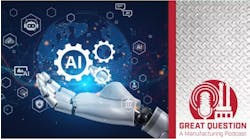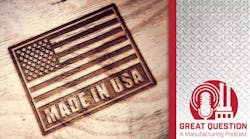Bright Machines' Adam Montoya
Nearly every industry has experienced dramatic shifts since the start of the Industry 4.0 revolution, when modern technology solutions started chipping away at once-traditional physical processes. Banking is done from our mobile phones, hiring new talent occurs on social media platforms, and doctors' visits are done over video conferencing.
In no uncertain terms, technological advancements have drastically changed so much of our world.
Both the Internet of Things (IoT) and the Industrial Internet of Things (IIoT) can be thanked for many of these improvements that have impacted our daily lives and how our businesses operate. IIoT, specifically, amplifies integration across the industrial sector so that machines used on the factory floor have a foundation of connectivity that wasn’t previously possible.
Notably, this level of connection is incredibly promising for businesses alike. McKinsey estimates that, by 2030, IoT could enable $5.5 trillion to $12.6 trillion in economic value globally, and B2B applications, specifically, are around 65% of that estimated value.
Many manufacturers, however, have largely remained hardware-centric. Even when they’ve started pulling in software and digitizing systems, it’s been primarily focused on design, engineering or supply chain operations rather than physical operations. That’s because marrying information technology (IT) and operational technology (OT) in the industrial sector has been historically limited due to large, expensive machines that are often inflexible—but that’s all changing.
Introducing software-defined manufacturing
Though IT and OT have largely been siloed, OT cannot lag behind IT because there cannot be one without the other. For starters, without the operational hardware, the value of the information is decreased—and in the world of manufacturing, what good is information if operations cannot shift in response to it? That’s why IT needs to work hand-in-hand with OT, so they can grow and achieve intended outcomes together.
That brings us to software-defined manufacturing—the future of the industry. Software-defined manufacturing leverages hardware designed from the software perspective, essentially centering logic and intelligence in the software instead of the hardware. This directly addresses the long-standing problem that manufacturers have experienced for decades: inherently inflexible hardware. By leveraging computer vision, machine learning, and adaptive robotics to create intelligent production lines, manufacturers can more easily configure, replicate, and scale automation on the factory floor and create greater transparency and accessibility across the rest of their operations.
Manufacturers who chose to move their factories to lower-cost labor markets due to the manual labor required with traditional automation now have an alternative solution. Intelligent automation comes to life with a software-defined manufacturing approach, enabling them to more easily move and sustain efficient operations closer to home, as they can rely more on digital production and less on manual labor.
What balanced IT/OT convergence looks like
Software-defined manufacturing can help manufacturers achieve operational excellence through connected applications, so manufacturers can truly converge IT and OT. This means they can better understand their operations, ultimately increasing resiliency, enhancing efficiency, and improving sustainability.
Here’s what balanced IT/OT convergence can provide manufacturers:
- Increased resiliency: When IT and OT truly connect and communicate, manufacturers experience greater adaptability by gaining the ability to adjust the types of data they monitor on the plant floor. This strengthens the decision-making process by understanding where there are opportunities to improve production lines, for example, or prevent downtime due to challenges with hardware. With real-time IT/OT insights at their fingertips, manufacturers can pivot when the unpredictable occurs, proactively address issues, and take advantage of new opportunities to improve production and uphold operational resiliency.
- Enhanced efficiency: With software-defined manufacturing comes intelligent, flexible manufacturing. If a manufacturer needs to program an assembly line to accommodate a quick-turn change order, or if they need to build multiple SKUs on the same line without changing out equipment, they can do so easily and quickly. This is made possible by intelligent software and adaptive robotics that communicate to identify continuous improvements and enable quick changes to production to increase efficiency.
- Improved sustainability: The future of manufacturing will undoubtedly require more sustainable production, and that’s exactly what software-defined manufacturing provides. Manufacturers can ramp production up or down based on actual demand to reduce waste, and if they move operations closer to the end customer and build smart factories, they can significantly reduce emissions associated with the global supply chain. It’s a win for the manufacturer, and it’s a win for the environment.
Indeed, converging IT and OT in the industrial sector has its hurdles, but when manufacturers allow their digital properties and their machinery to not only connect but truly communicate, the possibilities are endless. The future of manufacturing requires both IT and OT to be in lockstep, and that’s what software-defined manufacturing enables.
Adam Montoya is VP of industrial solutions at Bright Machines


